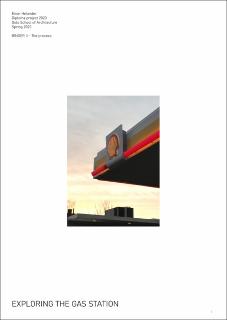| dc.description | The number of gas stations in Norway is in rapid decline. In central Oslo, only 17 are remaining. Considering the trend of the last decades, these buildings are well under the risk of being demolished. Is there a way for these stations to survive the death of the gasoline era? What are the potentials that exist in the architectural, spatial, and social aspects of these buildings, and how could these be explored as well as valued through a transformation?
This project is looking into the gas station and what architectural and programmatic potential they could have in a post-petroleum era. The ambition has been to understand these buildings through locating unique aspects that might be worth valuing and/or reusing and testing it out architecturally on a case study in Vinderen.
I located what I saw as fairly unique key aspects of the gas station: its layers of social culture surrounding it, its colourful expressions, its constant flow and motion, and its difficult relation to the soil. When preserving a gas station, how could these be used through architecture and new programs?
Although this project is focusing on one station in particular, it should be seen as a test for the gas station in general. The purpose has been to explore how the key aspects could be translated into architecture and program and still have the possibility to be adapted to other stations.
Through working with soil remediation, movement, and colour, I have proposed a strategy that is rooted in community engagement and social activity. How could the local community be a part of the shaping of what the post-petroleum era looks like? By providing small architectural tools, I have attempted to create conditions for the site to be in constant motion and change, while remaining accessible, social, and constantly reactivated by colour. | en_US |


